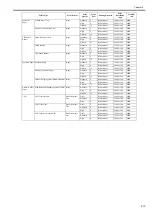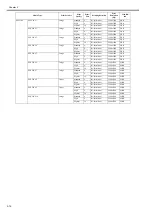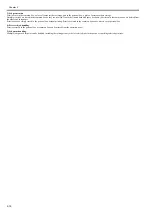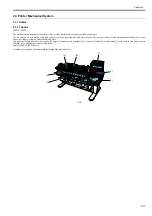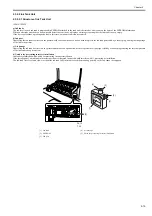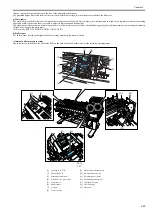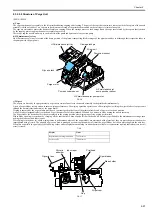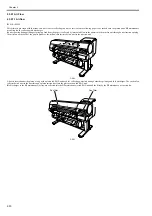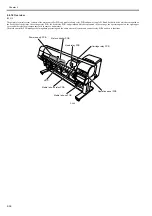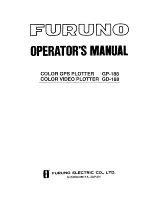
Chapter 2
2-27
2.3.2.5.2 Structure of Purge Unit
0020-5494
iPF810 / iPF820
a) Caps
The caps cap the nozzle assembly in the left printhead during capping and cleaning. The part of the caps that comes into contact with the face plate of the nozzle
assembly is made of rubber. Two caps are in position to meet each of the printheads mounted on the carriage (six trains of nozzles).
The caps are activated to protect the nozzle assembly on capping. When the carriage moves to the home position , the caps are elevated by the cap can that is driven
by the capping motor, capping the nozzle assembly to protect it.
These caps cap the nozzle assembly to suck inks from the printhead by means of the suction pump.
b) HP maintenace jet tray
An HP maintenace jet tray is located at the home position of the platen, transporting idle discharges of the pigment and dye inks through their respective tubes to
the pump unit in the purge unit.
F-2-16
c) Wipers
The wipers are driven by the purge motor to wipe the six trains of nozzles in the nozzle assembly in the printhead simultaneously.
A pair of wiper blades are in position to ensure wiping performance. The wiping operation operates on a slide wiping basis, sliding the wiper blades via wiper cams
through the normal rotation normal of the purge motor.
Wiping is executed by the wiper blades moving at a constant speed to the front of the printer after the end of a print or suction operation.
A wiper blade set perpendicularly to the head wipes the entire face of the printhead, followed by a narrower blade wiping the nozzle assembly.
The wiper blades are cleaned before they are replaced at the wiping position after wiping to preserve wiping performance.
Wiper blade cleaning is carried out by scraping off the inks that have been wiped off from the head with an ink scraper linked to the maintenance cartridge, then
wiping the blades with a blade cleaner.
Wet wiping is carried out for added wiping removal performance, whereby the wiper blades are moistened with glycerin as they are pressed against an absorber
impregnated with glycerin. The quantity of glycerin used is managed by counting the number of times the wiper blades have been pressed against the absorber.
When this count falls to equal any of the following values, either a replacement warning (continued print available) or replacement required indication (service call
error) is issued.
T-2-9
F-2-17
Display
Times
Replacement warning indication
71,250 times
Service calls
75,000 times
Wiper unit
Carriage lock pin
Purge motor
HP maintenance jet pump motor
HP maintenance jet
pump encoder sensor
HP maintenance jet tray
Glycerin tank
Pump encoder sensor
Pump cam sensor
Cap
Ink scraper
Glycerin
absorber
Printhead
Wiper blades
Blade holder
Glycerin tank
Wiper cam
Summary of Contents for iPF800 Series
Page 1: ...Aug 13 2008 Service Manual iPF800 series ...
Page 2: ......
Page 6: ......
Page 11: ...Chapter 1 PRODUCT DESCRIPTION ...
Page 12: ......
Page 14: ......
Page 38: ...Chapter 1 1 24 Hold this lever to pull out the lower roll unit ...
Page 100: ...Chapter 1 1 86 ...
Page 101: ...Chapter 2 TECHNICAL REFERENCE ...
Page 102: ......
Page 158: ......
Page 159: ...Chapter 3 INSTALLATION ...
Page 160: ......
Page 162: ......
Page 176: ...Chapter 3 3 14 ...
Page 177: ...Chapter 4 DISASSEMBLY REASSEMBLY ...
Page 178: ......
Page 180: ......
Page 238: ...Chapter 4 4 58 ...
Page 239: ...Chapter 5 MAINTENANCE ...
Page 240: ......
Page 242: ......
Page 246: ...Chapter 5 5 4 5 Close upper cover 1 F 5 6 1 ...
Page 247: ...Chapter 5 5 5 ...
Page 248: ......
Page 249: ...Chapter 6 TROUBLESHOOTING ...
Page 250: ......
Page 252: ......
Page 274: ......
Page 275: ...Chapter 7 SERVICE MODE ...
Page 276: ......
Page 278: ......
Page 301: ......
Page 302: ......
Page 303: ...Chapter 8 ERROR CODE ...
Page 304: ......
Page 306: ......
Page 318: ...Chapter 8 8 12 ...
Page 319: ...Aug 13 2008 ...
Page 320: ......

